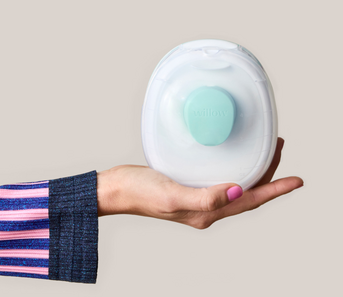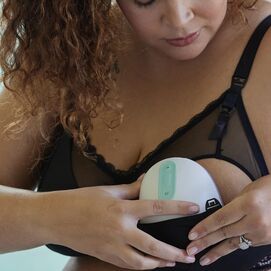If you’re wondering how the number of feeds you do at night impacts your supply (and by extension, your sleep), you’re not alone. They’re linked, but it’s complicated—and to some extent, beyond your control.
That’s because everybody’s breasts are biologically different. Your own breast storage capacity dictates how many times every 24 hours you need to remove milk from your breasts to maintain a stable supply that meets your baby’s growth needs. It’s an around-the-clock supply and demand.
Some people, for example, might need to breastfeed or pump three times a night to maintain an adequate milk supply, says Dr. Laurie Jones, founder of Dr. MILK (Mothers Interested in Lactation Knowledge). Others might need to do it only once. (She calls these “unicorn” breasts.)
Getting a general feel for how frequently you need to breastfeed or pump to maintain your supply can help you set (and meet) your sleep and feeding goals.
Learn Your Newborn's Sleep Patterns
Every baby is different, every parent is different, and every relationship is different. As your baby rapidly grows and develops, you’ll adjust to their changing needs—including at night.
Dr. Jones advises against comparing your breastfeeding experience to those of others, and instead to focus on getting to know your baby’s patterns.
“Each baby is different, but we know a general range by age and stage,” she says. Many babies need four to five night feeds (between 8 p.m. and 6 am.) in the first two months, and two to three in the next 10 months. “There will be variations from day to day, depending on the various reasons a baby may want to nurse or feed—like hunger, comfort, and/or growth spurts.”
Read Also: Postpartum Sleep Strategies
Align your sleep and feeding goals
As you get to know your baby, you’re also “figuring out your breasts,” as Dr. Jones puts it—as well as learning how much sleep you need to function.
“If you, as a parent, need more sleep, and you need to lower how many overnight milk removals you have to get that sleep, then your supply may go down,” says Dr. Jones. “If you are OK using milk other than your own in your feeding targets, that's an informed decision you can make.”
Breastfeeding, especially in the early weeks, is an around-the-clock job. So if your sleep and feeding goals aren’t aligned, then either your sleep or your supply will take a hit, Dr. Jones says. “Often parents with low milk supply may have not connected the dots between how sleeping longer at night can lower milk production.”
If your baby is sleeping longer stretches at night, there’s no work-around, like adding feeding sessions to daytime. “It's like telling your breasts to supply and supply and supply during the day, and then to stop and stop and stop at night,” Dr. Jones says. Because breast milk production is pretty consistent across 24 hours, “You can’t trick your breasts into making more during the day and slowing down at night. Breasts can’t tell time; they don’t understand emptying every two hours during the day and no emptying at night.”
Furthermore, it’s normal for babies to wake up to feed two to three times per night during the first year of life. “It protects them from SIDS,” she says. “And it makes them feel loved.”
Set Up Postpartum Support
If you have a partner or someone willing to help, work together to achieve your feeding and sleep goals. If it makes sense for your situation, consider splitting the night.
“This might mean that one person stays up late and wakes the baby for the early night feedings, while another gets rest and wakes up early to do the other nighttime feedings,” says Dr. Nicole M. Avena, a neuroscientist. “Having some predictability and teamwork can make life easier and ensure that everyone is getting their share of sleep—and your baby is getting all of their feedings.”
Willow 360™ Wearable Breast Pump
Willow 360™ Wearable Breast Pump
Willow 360 is designed with a zero-gravity latch to give you 360° of leak-proof mobility. It's the hands-free breast pump that changed the game.
Skip the dream feed, unless medically advised
So-called dream feeding has been relatively popular for at least several decades. It entails feeding a baby who’s still mostly asleep late at night, with the hopes of preventing them from waking up hungry shortly after you’ve drifted into an anticipated long stretch of sleep.
While some people may choose to do dream feeds, Dr. Jones says they aren’t really necessary—unless your pediatrician recommends it temporarily for medical reasons like poor weight gain. “Dream feeds are awesome for solving problems temporarily, but aren’t needed generally,” she says.
Try to Enjoy the Newborn Stage While It Lasts
While it’s easier said than done, understanding the peaks and valleys that come with parenting a newborn, especially when it comes to sleep and nutrition, can help you settle into your new reality. Regardless of how high your target supply amount or magic number is, your baby will gradually begin sleeping for longer stretches at night without waking up to feed.
Instead of trying to control or train your newborn, Dr. Jones recommends focusing on patiently learning about yourself, your breasts, and your baby. “You’ve created this little creature, and you want them to thrive,” she says. “The concept of control is a false narrative; babies can’t even be trained yet.”
That said, their behaviors are observable, and they can be introduced to routines through discovering who they are and what they need. You’re learning how to make this new life together work.
Learn Breastfeeding Tips and More with Willow
Navigating life after baby is hard. Your lifestyle is different, your body changes, and there are so many unknowns. It's easy to feel overwhelmed, but the good thing is that you are not alone. The Willow blog provides expert advice and resources to answer your questions and help you feel more prepared. You can do this!
Get pumping support with Simplifed
Get pumping support with Simplifed
Get access to free virtual feeding support from the lactation consultants at Simplifed. They can help you navigate supply issues, introduce a bottle, and more, and are trained on Willow pumps.















